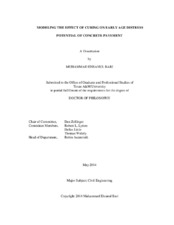| dc.description.abstract | Understanding the early age behavior of concrete is an important issue in construction of
concrete structures since different factors during construction, such as design
consideration, material usage, and environmental influence, can alter the original
configuration of the structure intended by the engineers and hence the structure may
experience and exhibit undesired consequences. The primary interest of this research
was to model the behavior of concrete under environmental excitations, such as the
variation of temperature and relative humidity, during the early age after concrete
placement. Experimental test results were obtained and mathematical models were
developed for this research.
Modeling the effect of curing process in response to the relative humidity
variation was one of the main objectives of this research. A mathematical model for
back-calculating the diffusion coefficient of cured concrete from experimental test was
proposed. This back-calculated diffusion coefficient of concrete was indicative of the
effectiveness of curing application provided during construction. Corner deflection
model for predicting lift-off displacement and climatic stress model for predicting crack
formations were formulated in order to predict the distress behavior of concrete for a
given design and construction scenario. Probabilistic models for lift-off displacement
and cracking were formulated to predict the probabilities of such distresses. Material
properties, such as strength, elastic modulus, creep, drying shrinkage, were obtained
from experimental program and were used as input in these distress prediction models.
In order to assess the effectiveness of different curing compounds, two indices,
such as curing index and overall curing index, were proposed. These indices were able to
distinguish the difference in performance among different curing compounds. For
validating the proposed corner lift-off displacement model and climatic stress model,
numerical simulations were performed and the obtained results were compared with the
field observations. The probabilistic models for predicting lift-off displacement and
cracking behavior were validated by comparing the numerical simulation results with the
field observations at Houston Intercontinental, TX. The predictions from these models
were found to be in close agreement with the experimental observations. Furthermore, in
order to assess the impact of a given design and construction, analytical study was
performed with these models. In the sensitivity analysis, parameters of interest were the
geometry of the structure, the effect of curing application, and the influence of time as
well as the season of construction on the distress potentials. Numerical simulations
indicated that the curing application was able to lower the early age distress potentials.
The thicker slabs/overlays versus the thinner ones exhibited differences in performance
in terms of distress potentials. The analytical study also revealed that it was possible to
vary the distress potentials by varying the time as well as the season of construction.
Finally, a constructability index was proposed in order to assist in decision making with
regard to different designs and construction scenarios with a view to minimize the
distress potentials in concrete structure. The results indicated that the constructability
index was able to capture and demonstrate the effect of different parameters mentioned
above on the constructability of rigid pavement/overlay projects. | en |


